Hopi Pueblo Left Handed Katsina - Kachina Doll - C3925i
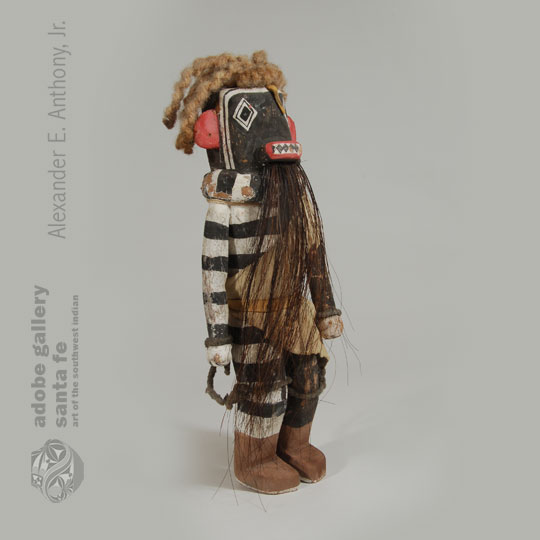 The Left Handed Katsina is so called because he carries his bow in his right hand rather than in his left. In fact, he generally does everything backwards. The reason for this is not clear. The Hopi say he came to them from the Chemehuevi Indians. He appears quite frequently in a great many dances, like the Mixed Kachina dance, in groups in the kivas or separately as a warrior in the Powamu Ceremony. He may act as a prompter in a dance or be found making odd little bows and taking small mincing steps at the edge of a procession. A great deal of the time he has trouble with Hó-e when they appear in the same dance. - Wright 1973
The Left Handed Katsina is so called because he carries his bow in his right hand rather than in his left. In fact, he generally does everything backwards. The reason for this is not clear. The Hopi say he came to them from the Chemehuevi Indians. He appears quite frequently in a great many dances, like the Mixed Kachina dance, in groups in the kivas or separately as a warrior in the Powamu Ceremony. He may act as a prompter in a dance or be found making odd little bows and taking small mincing steps at the edge of a procession. A great deal of the time he has trouble with Hó-e when they appear in the same dance. - Wright 1973
Two Grey Hills Navajo Rug with Soft Tones - C3925B
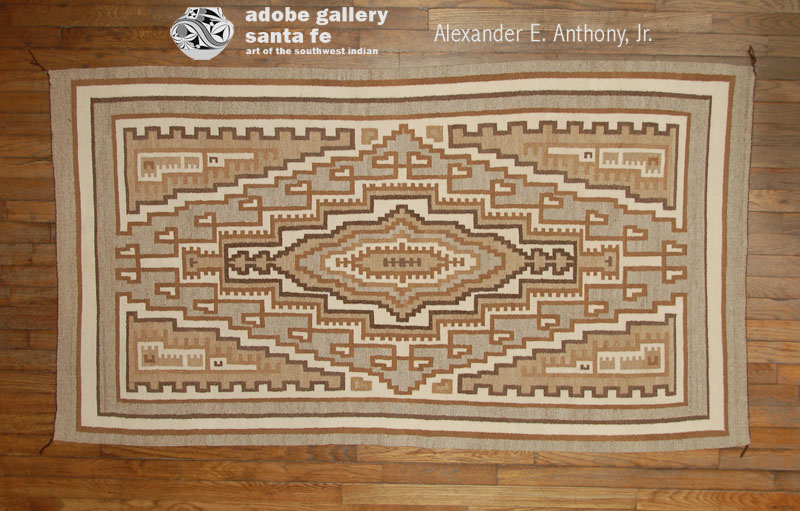 This rug from Two Grey Hills region of the Navajo Reservation was woven from all natural wool, probably from the weaver's own stock of sheep. The wool used was from brown and white sheep only. The light background tan color was achieved by carding white and brown wool with more white wool than brown. The other shades of brown were achieved in the same manner, but with more or less of one color of wool. The weaver, by not using black wool in the weaving, achieved a soft and mellow palette to the textile.
This rug from Two Grey Hills region of the Navajo Reservation was woven from all natural wool, probably from the weaver's own stock of sheep. The wool used was from brown and white sheep only. The light background tan color was achieved by carding white and brown wool with more white wool than brown. The other shades of brown were achieved in the same manner, but with more or less of one color of wool. The weaver, by not using black wool in the weaving, achieved a soft and mellow palette to the textile.
The weave of the rug is more suited for floor use than most Two Grey Hills textiles that are made of tapestry weave and therefore more suited as wall hangings. The soft color palette would be easy to decorate with.
Would you like to purchase or read more about this rug?
San Ildefonso Pueblo Mimbres Quail Painting by Tony Da - C3929C
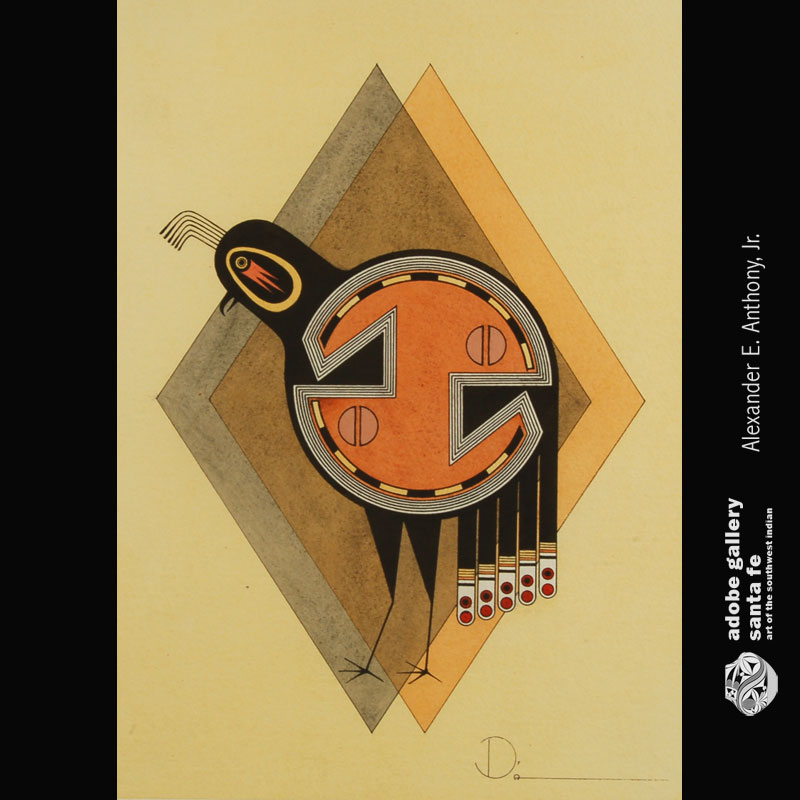 Tony Da was first a painter before becoming a potter. He began using casein paints in the 1950s and painted until he apprenticed to his grandmother, Maria Martinez, in the late 1960s. After 1972, he did very little painting and became a famous potter.
Tony Da was first a painter before becoming a potter. He began using casein paints in the 1950s and painted until he apprenticed to his grandmother, Maria Martinez, in the late 1960s. After 1972, he did very little painting and became a famous potter.
Tony was enchanted with the art of the Mimbres Indians of New Mexico and many of his paintings reflect that interest. This painting is an excellent example of such. It is his version of a Quail in the way a Mimbres painter might have painted it on the inside of a pottery bowl. Of course, the Mimbres only painted images in black pigment on white pottery, but Tony expanded the color palette.
Would you like to purchase or read more about this painting?
Ancestors Silhouetted by the Sun Hopi Pueblo Painting by Dan Namingha - 25990
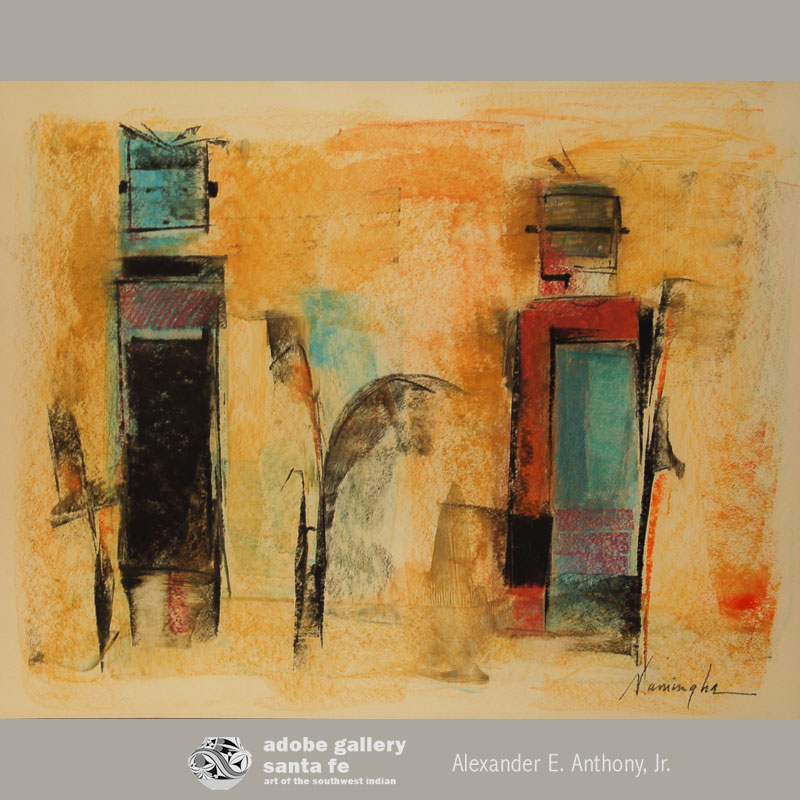 Dan Namingha (1950- ) is from the Hopi-Tewa village of First Mesa. He is a member of the famous Nampeyo family. His mother is Dextra Nampeyo and his grandmother was Rachel Namingha Nampeyo. He was born in 1950 and attended High School at Keams Canyon, Arizona, the University of Kansas and then the Institute of American Indian Arts in Santa Fe where he came under the influence of Otellie Loloma who encouraged him to experiment with his art. He began his art career painting in realistic style and then, around 1972, began to paint in a more abstract manner. Teachers at IAIA, such as Otellie Loloma, Allan Houser, and Fritz Scholder, encouraged the students to expand their horizons and paint creatively, which many did.
Dan Namingha (1950- ) is from the Hopi-Tewa village of First Mesa. He is a member of the famous Nampeyo family. His mother is Dextra Nampeyo and his grandmother was Rachel Namingha Nampeyo. He was born in 1950 and attended High School at Keams Canyon, Arizona, the University of Kansas and then the Institute of American Indian Arts in Santa Fe where he came under the influence of Otellie Loloma who encouraged him to experiment with his art. He began his art career painting in realistic style and then, around 1972, began to paint in a more abstract manner. Teachers at IAIA, such as Otellie Loloma, Allan Houser, and Fritz Scholder, encouraged the students to expand their horizons and paint creatively, which many did.
Would you like to purchase or read more about this painting?
Nambe Pueblo Very Large Micaceous Jar by Lonnie Vigil - C3924M
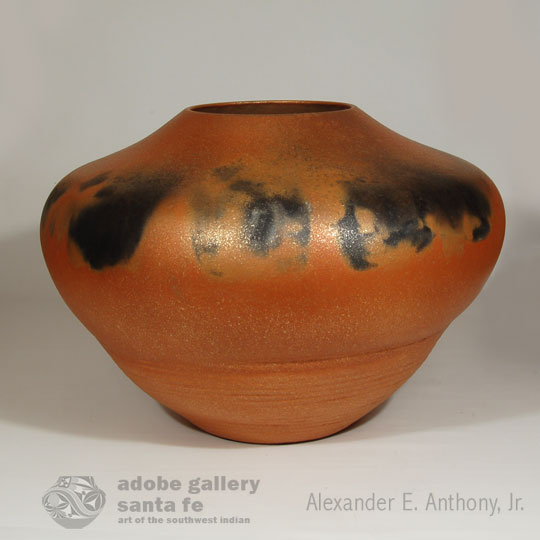 This large jar was made about 25 years ago by Lonnie Vigil and it is in excellent original condition. It displays a beautiful array of fire clouds. It is signed on the bottom with the artist's name and pueblo. The jar was awarded an Honorable Mention at the Santa Fe Indian Market in 1991.
This large jar was made about 25 years ago by Lonnie Vigil and it is in excellent original condition. It displays a beautiful array of fire clouds. It is signed on the bottom with the artist's name and pueblo. The jar was awarded an Honorable Mention at the Santa Fe Indian Market in 1991.
The lower 1/3rd of the jar is ribbed because of the jar having been started in a basket, the old-fashioned way of a hundred years ago. Lonnie not only has revived micaceous pottery at Nambe Pueblo, but has revived the ancient way in which it was formed. His masterful firing technique produced beautiful fire clouds on the shoulder of the jar.
Would you like to purchase or read more about this pottery?
Hunter Communicating with a Deer Painting by Soe Khuwa Pin - C3918F
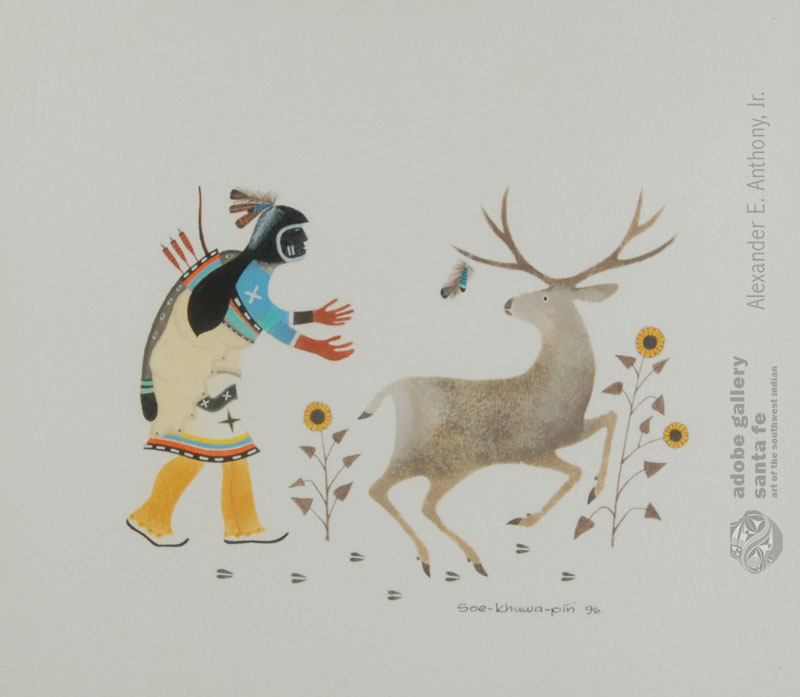 The painting of a Hunter Communicating with a Deer was executed in watercolor on handmade paper. It is floated on backing material to permit the entire paper to be visible and free of mat covering. It is signed in lower right with the artist's native name and dated 1996.
The painting of a Hunter Communicating with a Deer was executed in watercolor on handmade paper. It is floated on backing material to permit the entire paper to be visible and free of mat covering. It is signed in lower right with the artist's native name and dated 1996.
Robert Montoya was born in 1947, and is the son of Ohkay Owingeh painter and former Santa Fe Indian School art department head, Gerónima Cruz Montoya. Mrs. Montoya began her teaching career as assistant to Dorothy Dunn. Robert Montoya has multiple degrees in architecture and has experience as an architect. He resides at Sandia Pueblo.
Would you like to buy or read more about this painting?
Hopi Na’somta Tsutsukutu - Hairknot Clown Katsina by Tyson Namoki - C3383Y
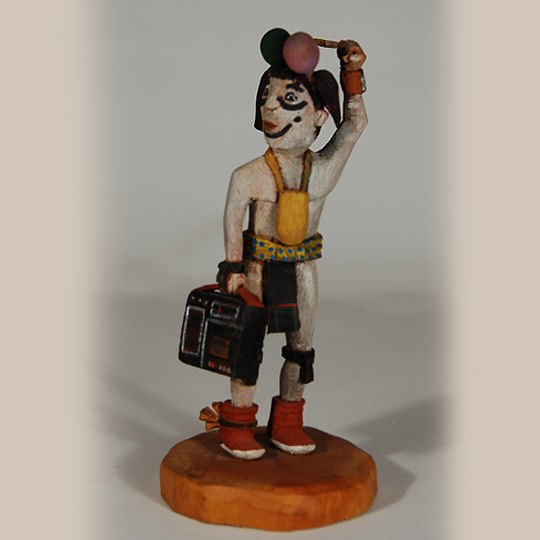 There is a group of Hopi Clowns named Tsutskutu, some of which have yellow body paint and are known as Sikya Tsuku and others with white body paint and known as O-oto Tsuku. The Na'somta Tsutsukutu clown illustrated here is one of the O-oto Tsuku clowns. The name derives from the manner in which they have their hair tied in a knot, thus the Hairknot Clown.
There is a group of Hopi Clowns named Tsutskutu, some of which have yellow body paint and are known as Sikya Tsuku and others with white body paint and known as O-oto Tsuku. The Na'somta Tsutsukutu clown illustrated here is one of the O-oto Tsuku clowns. The name derives from the manner in which they have their hair tied in a knot, thus the Hairknot Clown.
Would you like to buy or read more about this katsina doll?
#adobegallery #HopiPueblo #Katsina #Kachina # #Doll #SouthwestIndianArt #PuebloArt #SantaFeNM #TysonNamoki
Two Eagle Dancers, Singers and Drummers Painting by Pan-Yo-Pin - C3918i
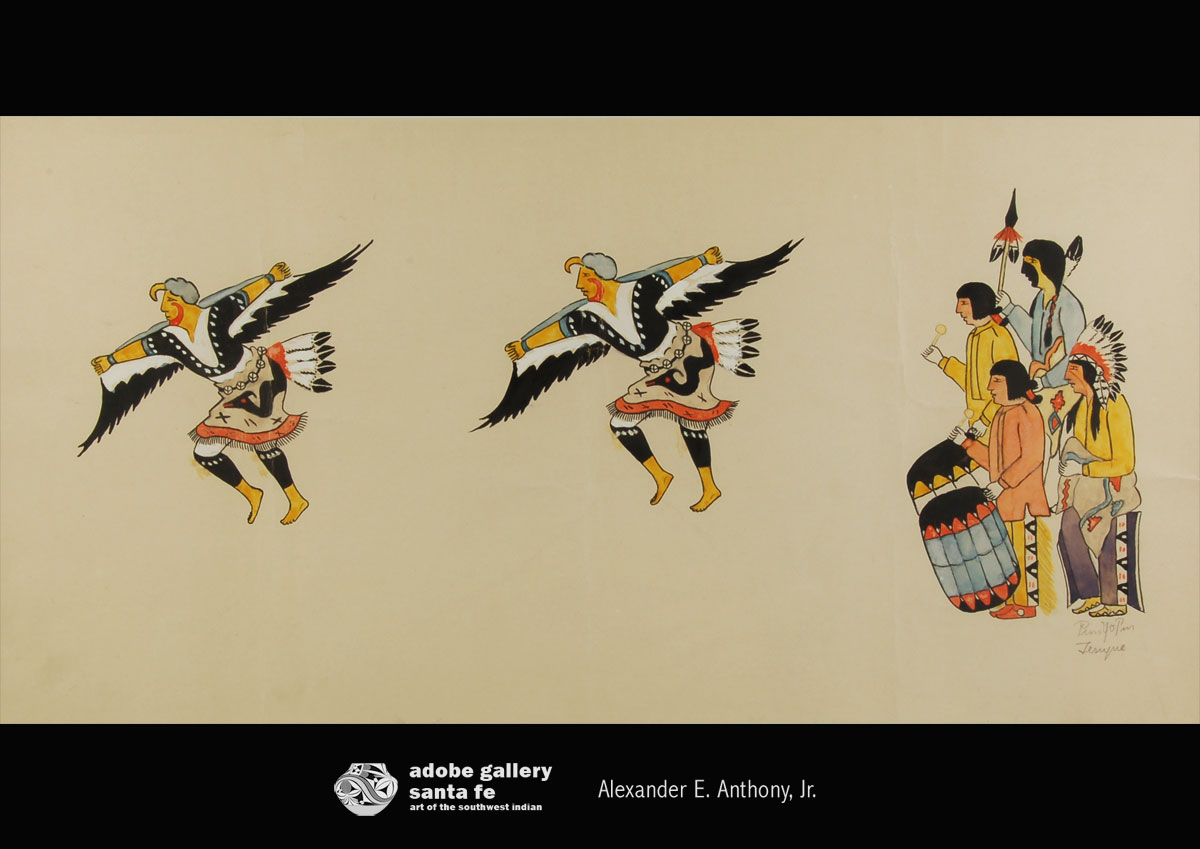 The Eagle Dance is performed in early spring and repeated from time to time during the summer. The eagle is believed to have direct intercourse with sky powers and is much venerated by the Pueblo Indians. The Pueblo Eagle Dance is a dramatization of the relationship between the eagle and man and supernatural powers. Generally, two young men, costumed as eagles, imitate, during the dance, almost every movement possible of the eagles. They replicate eagles soaring over the fields, perching on high places, and resting on the ground.
The Eagle Dance is performed in early spring and repeated from time to time during the summer. The eagle is believed to have direct intercourse with sky powers and is much venerated by the Pueblo Indians. The Pueblo Eagle Dance is a dramatization of the relationship between the eagle and man and supernatural powers. Generally, two young men, costumed as eagles, imitate, during the dance, almost every movement possible of the eagles. They replicate eagles soaring over the fields, perching on high places, and resting on the ground.
Nineteenth Century Lakota Sioux Pipe Bag - C3923
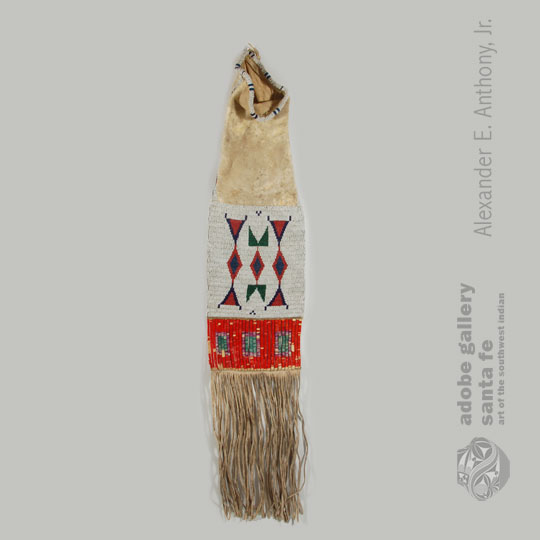 It was traditional for every Indian man to carry a decorated pipe bag made from deer or buffalo skin and highly decorated with beads. The bag would contain a pipe, tobacco, tamping stick and a strike-a-light. The Indians did not smoke purely for pleasure but did smoke tobacco for important rituals. Pipe smoking was part of any ceremonial or social event.
It was traditional for every Indian man to carry a decorated pipe bag made from deer or buffalo skin and highly decorated with beads. The bag would contain a pipe, tobacco, tamping stick and a strike-a-light. The Indians did not smoke purely for pleasure but did smoke tobacco for important rituals. Pipe smoking was part of any ceremonial or social event.
Warriors would smoke when seeking spiritual power; sacred acts were celebrated by smoking; oaths and friendships were sealed by smoking; visits to another person were celebrated by smoking before any conversation ensued; and smoking was undertaken for any major rituals.
Would you like to buy or read more about this pipe bag?
Zuni Pueblo Atosh'le Katsina Doll - C3535.19
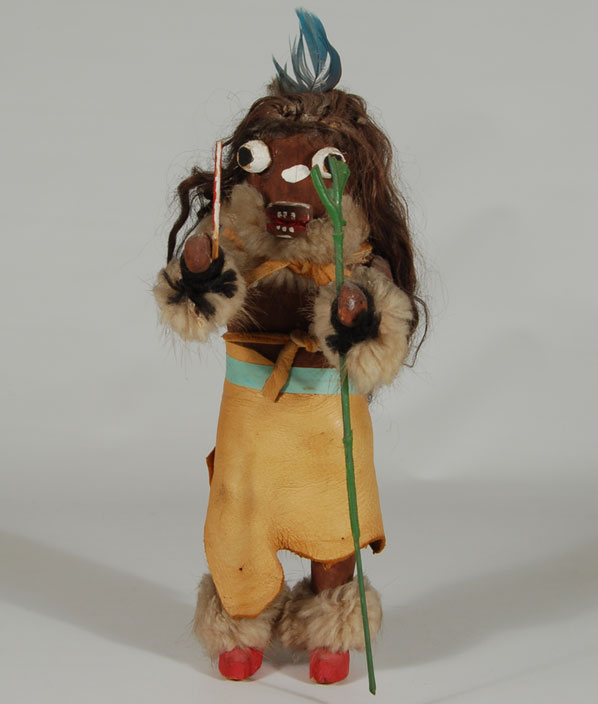 In this carving, the maker has added a basket on the back of the ogre and placed a miniature Koyemshi Katsina doll in the basket as if the ogre has captured one of the Koyemshi who accompanies him on his rounds. The doll is typically Zuni in style, that is, it has been dressed in clothing. The arms have been secured to the body and do not articulate. The doll does stand unaccompanied but could be hung if desired.
In this carving, the maker has added a basket on the back of the ogre and placed a miniature Koyemshi Katsina doll in the basket as if the ogre has captured one of the Koyemshi who accompanies him on his rounds. The doll is typically Zuni in style, that is, it has been dressed in clothing. The arms have been secured to the body and do not articulate. The doll does stand unaccompanied but could be hung if desired.
Very Large Hopi Pueblo Open Bowl by Frogwoman - C3910A
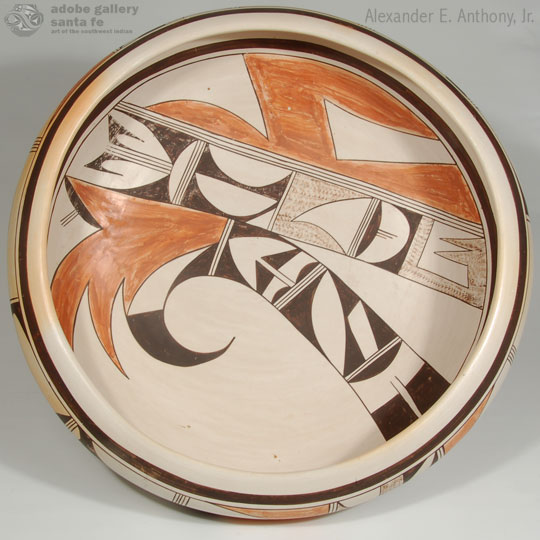 This bowl is a major accomplishment by Joy Navasie. It is exceptionally large and beautifully presented. The walls have a mathematically-precise curve with a significant overhang at the rim. A 1-3/4-inch wide band of painted design fills the exterior wall and a Sikyatki-inspired design fills the interior bottom. There is a beautiful golden blush on the exterior from the firing process. Joy Navasie was an accomplished potter who earned the praise bestowed on her and her work.
This bowl is a major accomplishment by Joy Navasie. It is exceptionally large and beautifully presented. The walls have a mathematically-precise curve with a significant overhang at the rim. A 1-3/4-inch wide band of painted design fills the exterior wall and a Sikyatki-inspired design fills the interior bottom. There is a beautiful golden blush on the exterior from the firing process. Joy Navasie was an accomplished potter who earned the praise bestowed on her and her work.
Contemporary Ledger Art Painting by Terrance Guardipee - C3906A
 Terrance Guardipee is an internationally acclaimed Blackfeet painter and ledger artist, consistently recognized for the traditional depiction of his Blackfeet heritage and contemporary innovation demonstrated in his work. Terrance was one of the first Native artists to revive the historical ledger art tradition, and was the first ledger artist to transform the style from the single page custom into his signature map collage concept. The map collage concept is based in the ledger art style, but incorporates various antique documents such as maps, war rations, checks, in addition to single page ledgers. Terrance utilizes antique documents in his artwork, dating from the mid-19th century, and typically originating from the historical and present Blackfeet homeland of Montana.
Terrance Guardipee is an internationally acclaimed Blackfeet painter and ledger artist, consistently recognized for the traditional depiction of his Blackfeet heritage and contemporary innovation demonstrated in his work. Terrance was one of the first Native artists to revive the historical ledger art tradition, and was the first ledger artist to transform the style from the single page custom into his signature map collage concept. The map collage concept is based in the ledger art style, but incorporates various antique documents such as maps, war rations, checks, in addition to single page ledgers. Terrance utilizes antique documents in his artwork, dating from the mid-19th century, and typically originating from the historical and present Blackfeet homeland of Montana.
Terrance is an enrolled member of the Blackfeet Nation of Montana, and illustrates his personal experience of Blackfeet culture in combination with his educational experience in his artwork. Terrance was raised in the Blackfeet homeland in northern Montana, and, as a result, the cultural life and history of the Blackfeet people became a foundational part of his identity. Moreover, he regularly participates in the traditional Blackfeet ceremonies often depicted in his artwork. Terrance's understanding and personal knowledge of authentic Blackfeet history and traditional culture is expressed in his work. Terrance lived in Montana until he attended the Institute of American Indian Arts (IAIA) located in Santa Fe, New Mexico, where he studied two-dimensional arts. His educational experience at IAIA enabled him to incorporate the contemporary color palate he is known for in a manner that is consistent with Blackfeet tradition.
Would you like to buy or read more about this painting?
Historic Hopi Pueblo Polychrome Bowl with Incurving Rim - 25980
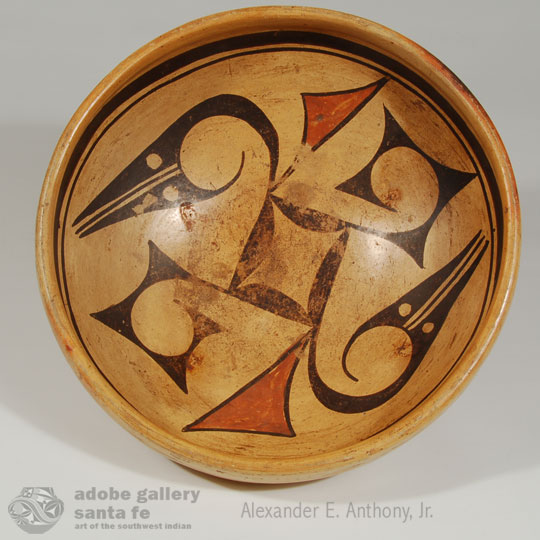 This bowl was beautifully constructed with a graceful curve from its base to the rim. The exterior is bathed in wonderful fire clouds. The interior features an uncluttered precisely executed design that starts with a square in the bottom of the bowl and with appendages from the four corners of the square. The patina is that of a well-used and lovingly-handled bowl. The color is warm and rich. Overall, it is a beautiful bowl.
This bowl was beautifully constructed with a graceful curve from its base to the rim. The exterior is bathed in wonderful fire clouds. The interior features an uncluttered precisely executed design that starts with a square in the bottom of the bowl and with appendages from the four corners of the square. The patina is that of a well-used and lovingly-handled bowl. The color is warm and rich. Overall, it is a beautiful bowl.
Tesuque Pueblo Mixed Animal Dance Painting by Tomás Vigil (Pan-Yo-Pin) - C3918J
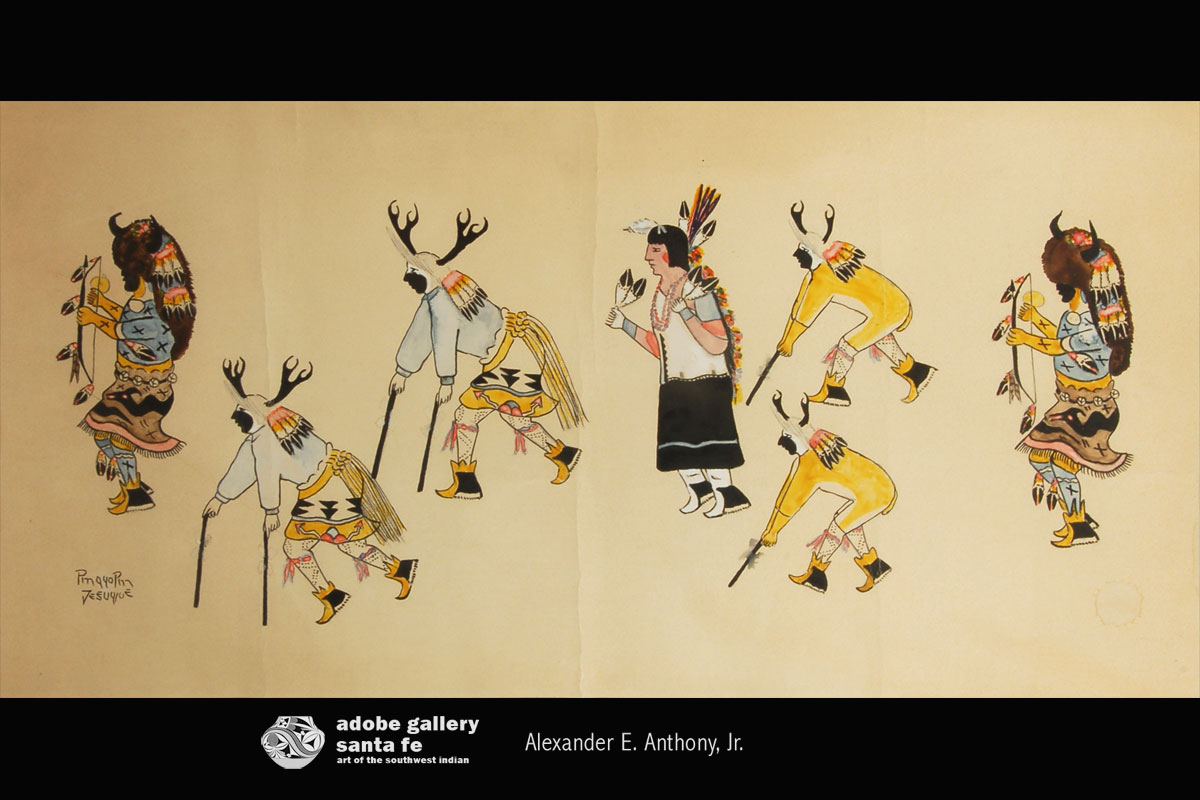
Animal dances at New Mexico pueblos are performed in the fall and winter as a celebration of thanksgiving for bountiful game. Deer, antelope, rams and buffalo are often seen in the same dance. The hunter takes on the spirit of the animal he has hunted during the year. He thanks the spirit of that animal, and he asks for good luck for next year's hunt. Animal Dances are popular subjects for artists to paint.
Tomás Vigil presents Buffalo, Deer and Antelope Dancers accompanied by a single female dancer. He has painted the subject in the traditional pueblo style of no ground plane or landscape features. His works are generally primitive in a folk-art style but with vivid colors. His attention to detail was quite well known.
Would like to buy or read more about this painting?
Bone Horse and Glass Bead Necklace and Earrings Set by Robert Kaniatobe - C3920A
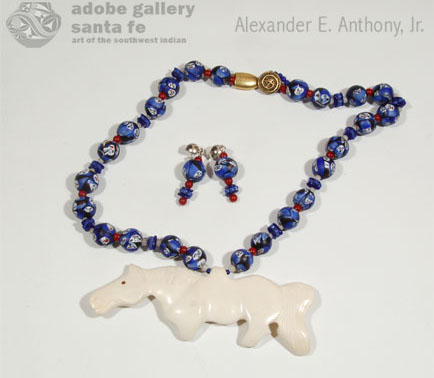 Robert Kaniatobe (1936-1998), of the Choctaw Tribe, was well known for making marvelous necklaces comprised of a multitude of materials. This one focuses on a horse, carved from buffalo bone, and combined with beautiful glass beads. There are 24 round blue glass beads with designs, separated by smaller beads. Suspended from the necklace is a large hand-carved white horse, which is finished on both sides, so either side may be exposed. A pair of earrings accompanies the necklace.
Robert Kaniatobe (1936-1998), of the Choctaw Tribe, was well known for making marvelous necklaces comprised of a multitude of materials. This one focuses on a horse, carved from buffalo bone, and combined with beautiful glass beads. There are 24 round blue glass beads with designs, separated by smaller beads. Suspended from the necklace is a large hand-carved white horse, which is finished on both sides, so either side may be exposed. A pair of earrings accompanies the necklace.
Cochiti Pueblo Bear Storyteller with Four Cubs by Virginia Naranjo - C3919B
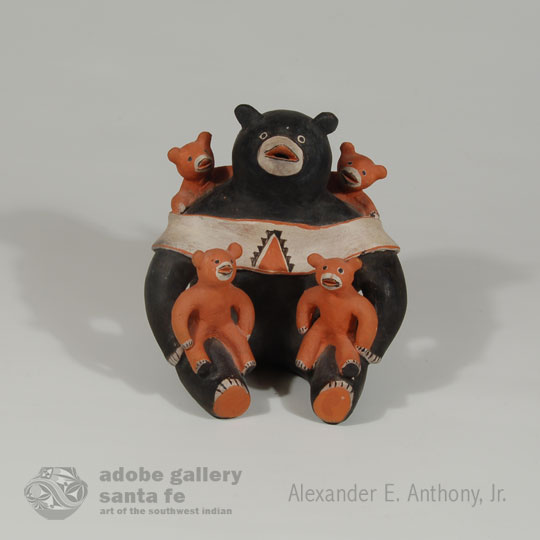 Louis (1932-1997) and Virginia Naranjo (b.1932) worked together for many years forming figurative pottery. They made storyteller figurines, large human figures, animals, and other forms of pottery. Louis created the bear storyteller figurine sometime in the 1970s after having seen a bear family, and the cubs were playing around.
Louis (1932-1997) and Virginia Naranjo (b.1932) worked together for many years forming figurative pottery. They made storyteller figurines, large human figures, animals, and other forms of pottery. Louis created the bear storyteller figurine sometime in the 1970s after having seen a bear family, and the cubs were playing around.
Zia Pueblo Male Dancer Painting by Rafael Medina - C3918H
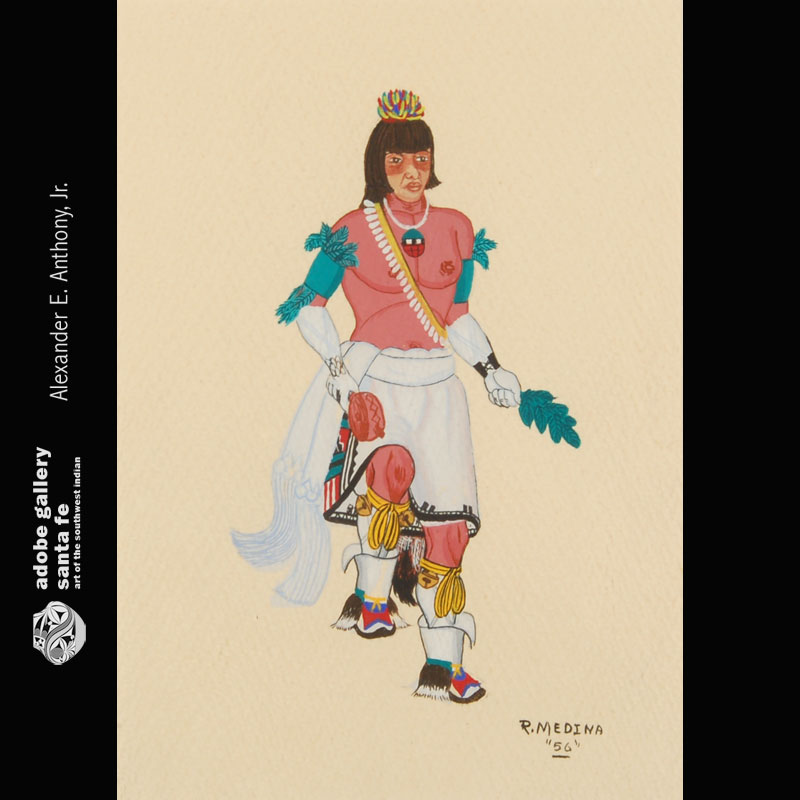 Zia Pueblo artist Medina illustrated early in his life that he was a talented painter, following in the footsteps of Zia's most famous painter of the time, Ma Pe Wi. This painting by Medina is softer in tone than his later works. His later works are brighter as if painted with acrylic paints. In traditional Santa Fe Indian School style, he painted the main subject without ground plane and background. One cannot be not impressed with the amazing detail of the costuming of the dancer. It is such detail that gave Medina his reputation.
Zia Pueblo artist Medina illustrated early in his life that he was a talented painter, following in the footsteps of Zia's most famous painter of the time, Ma Pe Wi. This painting by Medina is softer in tone than his later works. His later works are brighter as if painted with acrylic paints. In traditional Santa Fe Indian School style, he painted the main subject without ground plane and background. One cannot be not impressed with the amazing detail of the costuming of the dancer. It is such detail that gave Medina his reputation.
Cochiti Pueblo Male Basket Dancer Painting by Tonita Peña - C3918D
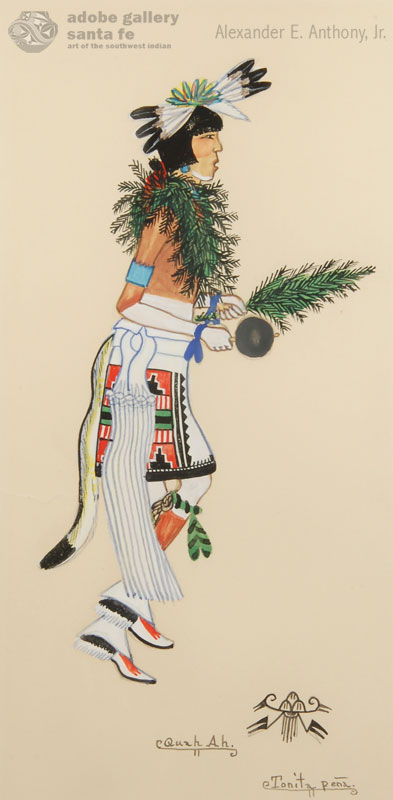 This painting is titled Basket Dance on verso and it features a single male dancer. The Basket Dance is performed by the Winter People at San Ildefonso around Easter time. This appears to be a later painting by Tonita Vigil Peña (1893-1949) Quah Ah as determined by her signature with the cartouche of a pottery design. By indicating this to be a later painting, we mean 1930s to mid-1940s, as she passed away in 1949.
This painting is titled Basket Dance on verso and it features a single male dancer. The Basket Dance is performed by the Winter People at San Ildefonso around Easter time. This appears to be a later painting by Tonita Vigil Peña (1893-1949) Quah Ah as determined by her signature with the cartouche of a pottery design. By indicating this to be a later painting, we mean 1930s to mid-1940s, as she passed away in 1949.
Tonita was an exceptional painter. She was the only female painter amongst a group of men painters. She well illustrated that she was as competent a painter as any of the men. She has been praised for her fine detail and the expertly rendered faces she painted. Her attention to detail is easily demonstrated when looking at the evergreen neck ruff and the branch held in his hand.
Would you like to buy or read more about this painting?
Historic Kewa Pueblo Rare Black-on-red Large Dough Bowl - 20606
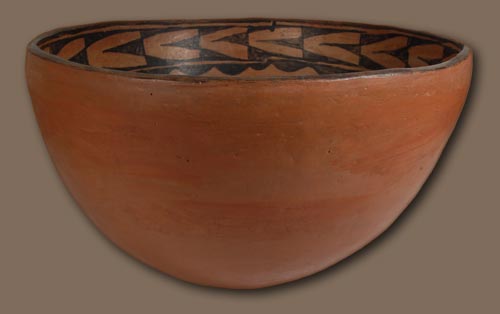 A very large, rare Santo Domingo Pueblo black-on-red pottery dough bowl. The interior is decorated with a "lazy V" design at the rim, under which is a continuous band of clouds. In the bottom of the inside is a dual floral design.
A very large, rare Santo Domingo Pueblo black-on-red pottery dough bowl. The interior is decorated with a "lazy V" design at the rim, under which is a continuous band of clouds. In the bottom of the inside is a dual floral design.
Black-on-red pottery at Kewa Pueblo appears to have had its beginning around 1880 or a little later. Whether it was a single family or not has not been determined. It is known that the Aguilar sisters made Black-on-red in the late 19th century (probably from 1890 to 1915) but whether they were the first is not known.
Would you like to buy or read more about this pottery?
Very Large Bear Cochiti Storyteller Figurine with 10 Cubs by Virginia Naranjo - C3919A
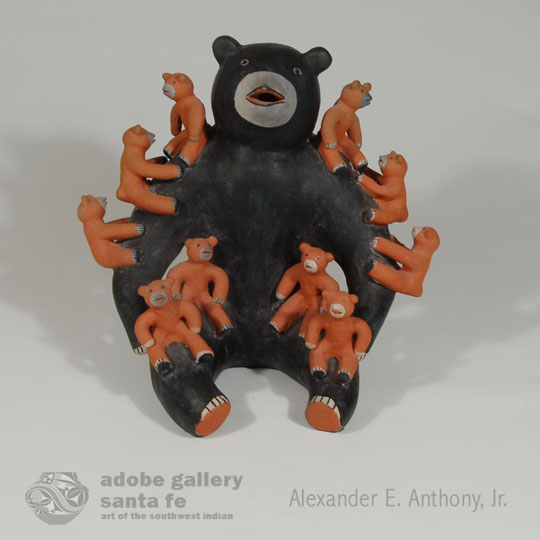 Louis (1932-1997) and Virginia Naranjo (b.1932) were standard bearers for the proud figurative pottery tradition of Cochiti Pueblo. They crafted their figurines at the kitchen table in their comfortable adobe home at the pueblo. They worked almost every day crafting their art with great care, joking and exchanging the gossip of the day as they went along, accompanied by television, children and grandchildren. Their art provided a good life for them and it provided a legacy that will be with us for another century or more.
Louis (1932-1997) and Virginia Naranjo (b.1932) were standard bearers for the proud figurative pottery tradition of Cochiti Pueblo. They crafted their figurines at the kitchen table in their comfortable adobe home at the pueblo. They worked almost every day crafting their art with great care, joking and exchanging the gossip of the day as they went along, accompanied by television, children and grandchildren. Their art provided a good life for them and it provided a legacy that will be with us for another century or more.
Louis once explained why he began making bear storytellers. He was hunting one day and came across a female bear with two cubs. He watched the cubs playing and their antics inspired him to create the bear figurines.
Would you like to buy or read more about this storyteller?

